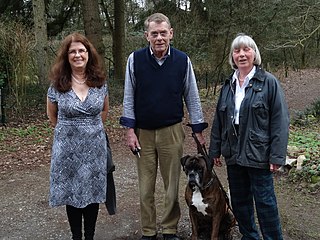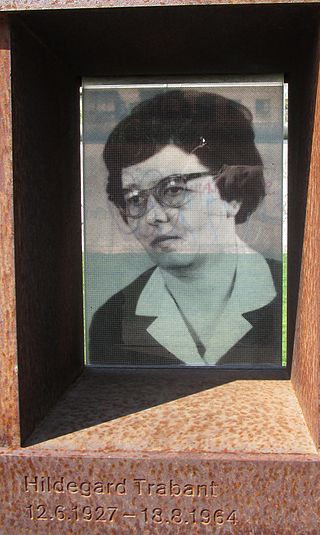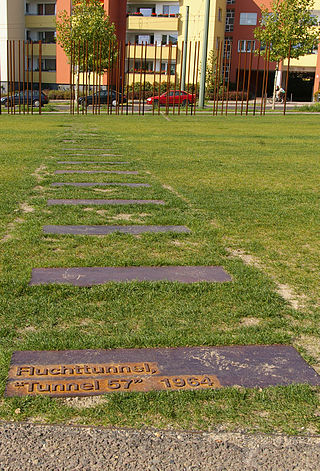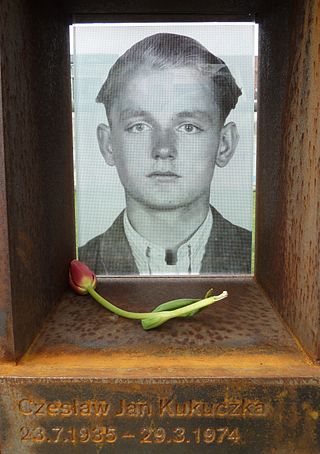Biography
He was his mother's only child, and grew up with her in Naumburg. His father is unknown. After school, he trained as a car mechanic. In Naumburg he took a job at the Deutsche Reichsbahn (East Germany). [1] [2]

Christian-Peter Friese (August 5, 1948, Munich - December 25, 1970, East Berlin) was one of the victims at the Berlin Wall. Members of the Border Troops of the German Democratic Republic shot him while trying to escape from East Germany.
He was his mother's only child, and grew up with her in Naumburg. His father is unknown. After school, he trained as a car mechanic. In Naumburg he took a job at the Deutsche Reichsbahn (East Germany). [1] [2]

On the evening of December 24, 1970, he left his home and his mother without saying goodbye or leaving a message. He went to East Berlin by train. Once there he went to the allotment Vogelsang II in Treptow which was right on the border. He watched the border and climbed around midnight on the interior fence. He triggered alarm by touching the subsequent signal fence. A total of five border guards opened fire on Christian-Peter Friese, who took cover in the vehicle barrier ditch. Shortly afterwards Friese began again to run in the direction of the last border fence. He was hit several times in the legs and upper body. He succumbed to his injuries in the death strip. In the crime scene sketch of the files of the Stasi were recorded a total of 98 shots on Christian-Peter Friese. [1] [2]
A senate speaker and the American City Commandant expressed their protest over the incident. The West-Berlin police initiated an investigation. [1] [2]
The mother of the deceased was informed on January 7, 1971, by members of the Stasi about the death. The legend was that Christian-Peter Friese was traveling by car into a tree. The body had been cremated. The urn was transferred one month later to Naumburg and buried there in the municipal cemetery, under the supervision of the Stasi. [1] [2]
After the German reunification, the mother said to Naumburg police that her son revealed his intention of fleeing. In a Mauerschützenprozess (process against guards of the wall who had shot) the border guards involved were acquitted because intent to kill could not be established, and because the court could not determine which of the defendants was responsible for the actual killing. [1] [2]

The Berlin Wall was a guarded concrete barrier that encircled West Berlin of the Federal Republic of Germany from 1961 to 1989, separating it from East Berlin and the German Democratic Republic. Construction of the Berlin Wall was commenced by the government of the GDR on 13 August 1961. It included guard towers placed along large concrete walls, accompanied by a wide area that contained anti-vehicle trenches, beds of nails and other defenses. The primary intention for the Wall's construction was to prevent East German citizens from fleeing to the West.

The inner German border was the frontier between the German Democratic Republic and the Federal Republic of Germany from 1949 to 1990. De jure not including the similar but physically separate Berlin Wall, the border was 1,381 kilometres (858 mi) long and ran from the Baltic Sea to Czechoslovakia.

Peter Fechter was a German bricklayer who became the twenty-seventh known person to die at the Berlin Wall. Fechter was 18 years old when he was shot and killed by East German border guards while trying to cross over to West Berlin.

Hans Conrad Schumann, also known as Konrad Schumann was an East German border guard who escaped to West Germany during the construction of the Berlin Wall in 1961.

Chris Gueffroy was the last person to be shot and the second-last to die in an escape attempt while trying to escape from East Berlin to West Berlin across the Berlin Wall.

Schießbefehl was the term in the German Democratic Republic for standing orders authorizing the use of lethal force by the Border Troops to prevent Republikflucht (defection) at the Inner German border from 1960 to 1989.

Night Crossing is a 1982 thriller drama film starring John Hurt, Jane Alexander and Beau Bridges. The film is based on the true story of the Strelzyk and Wetzel families, who on September 16, 1979 attempted to escape from East Germany to West Germany in a homemade hot-air balloon during the Inner German border-era when immigration to West Germany was strictly prohibited by the East German government. It was the final theatrical film directed by Delbert Mann, and the last in which Kay Walsh appeared before retiring.

Günter Litfin was a German tailor who became the second known person to die at the Berlin Wall. Litfin was the first victim to be killed by East German border troops, the first to succumb to gunshot wounds, and was the first male victim.

Marienetta "Micki" Jirkowsky was a German woman who became the one-hundred and twenty-fifth known person to die at the Berlin Wall. Jirkowsky was shot and killed by East German border guards during an escape attempt, and at 18 years was one of the youngest victims and the youngest of the 8 women killed at the Berlin wall.

Wolfgang Engels is a former civilian employee of the East German National People's Army, employed as a car mechanic and driver, who in 1963 used a stolen BTR-152 armoured personnel carrier to escape to West Germany by breaking through the Berlin Wall.

Heinz Sokolowski was a German man who became the sixty-fourth known person to die at the Berlin Wall. Sokolowski, a former political prisoner, was shot and killed by East German border troops while attempting to cross the Berlin Wall near to the Brandenburg Gate and the Reichstag building.
Cengaver Katrancı was a Turkish boy, who lived in West Berlin, in district of Kreuzberg. He drowned in the river Spree, which at the time and in this place was a border between East and West Berlin. In view of the circumstances surrounding the accident Cengaver Katrancı is one of the youngest victims of the Berlin Wall's existence.

Hildegard Johanna Maria Trabant was an East German woman who became the fiftieth known person to die at the Berlin Wall. Trabant was shot and killed by East German border guards during a crossing attempt, one of only eight women victims of the Berlin Wall, and was the only escapee victim known to have a record of loyalty toward the East German regime.

Egon Schultz was a German sergeant of the East German Border Troops who became the fifty-second known person to die at the Berlin Wall. While responding to the discovery of "Tunnel 57," Schultz was killed during a shootout with the tunnelers. Schultz subsequently became a national hero in East Germany, with hundreds of memorials and schools named in his honor. His death caused a public sensation in both East Germany and West Germany. Following the reunification of Germany and the report that Schultz was actually killed as a result of friendly fire, many of the memorials to Schultz were removed, although a new memorial plaque was erected at his death site at Strelitzer Strasse 55, Berlin, in 2004.

Tunnel 57 was a tunnel under the Berlin Wall that on 3 and 4 October 1964 was the location of a mass escape by 57 East Berlin citizens to West Berlin. Built from the basement of an empty bakery at 97 Bernauer Straße in West Berlin, under the Berlin Wall – which at that time and place consisted of empty, bricked up apartment buildings on the east side of Bernauer Straße – all the way to a disused outhouse in the rear courtyard at 55 Strelitzer Straße in East Berlin. At a depth of 12 meters (40'), and a length of 145 meters (475'), Tunnel 57 was the longest, deepest and most expensive flight tunnel built in Berlin. 35 West Berliners, including Wolfgang Fuchs, the future astronaut Reinhard Furrer, and many students from the Freie University in West Berlin, helped to build the tunnel from April till October 1964, until on 3 and 4 October 57 people fled the GDR via the tunnel.

Dorit Schmiel was a German seamstress who became the thirteenth known person to die at the Berlin Wall. Schmiel was fatally shot by East German border guards while attempting to escape from East Berlin to West Berlin with a group of friends, including her fiancé. Schmiel was one of only eight women to die at the Berlin Wall, and at 20 years-old was the second youngest woman victim.
Klaus Brueske was a German truck driver who became the sixteenth person to die at the Berlin Wall. Brueske died in an attempt to break through the Heinrich-Heine-Straße border crossing in a truck, and was the first Berlin Wall victim to die from suffocation.

Dieter Wohlfahrt was an escape helper and the first non-German and non West Berlin resident to die at the Berlin Wall.

Czesław Kukuczka was a Polish man who became the 114th known person to die at the Berlin Wall. Kukuczka was assassinated during an attempt to threaten the Polish embassy in East Germany into allowing him to migrate to West Berlin, becoming one of only three non-German escapee victims of the Berlin Wall.